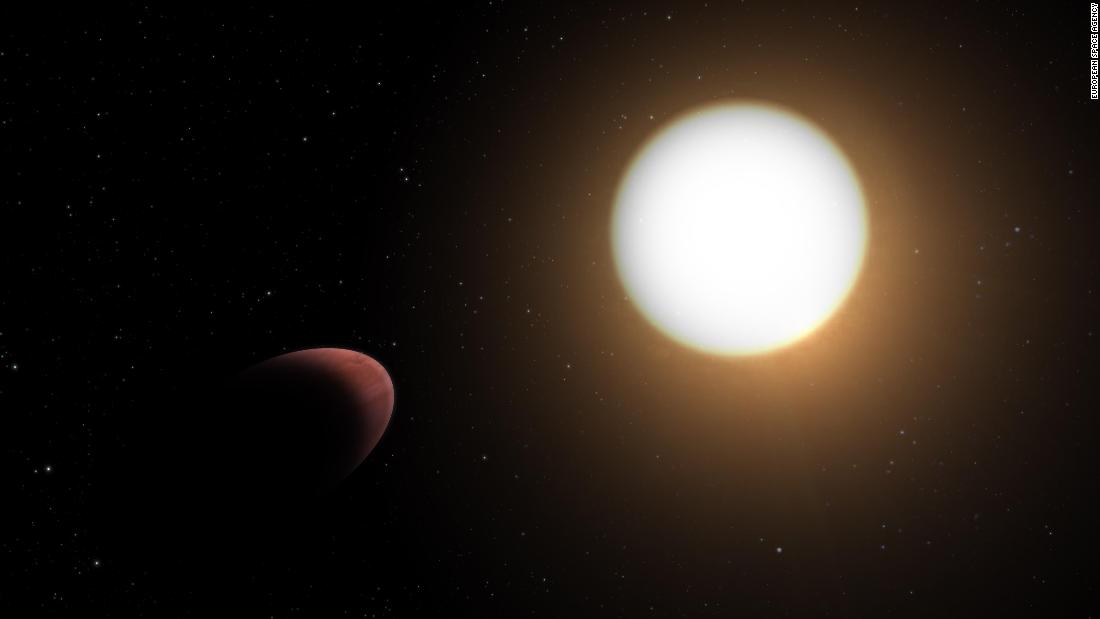In the search for planets beyond our solar system, astronomers found a giant exoplanet that looks more like a football or rugby ball than a sphere.
The planet, called WASP-103b, is one of the extremes. Located about 1,225 light-years from Earth in the constellation of Hercules, the planet is nearly twice the size of Jupiter.
The strange world is also 50 times closer to its star than Earth is to the sun. It completes a full orbit around its star, WASP-103, in just under an Earth day. With its scale and short orbit, this gas giant is classified as a “hot Jupiter” planet.
The planet was first discovered in 2014 and has been observed using the Hubble and Spitzer space telescopes. The researchers wanted to get another perspective on WASP-103b using CHEOPS, or the joint mission of Switzerland and the European Space Agency’s ExOPlanet Characterization Satellite, to combine with earlier observations.
The satellite, launched in 2019, searches for potentially habitable planets. It detects planets using the transit method, or by measuring dips in stellar brightness as a planet passes in front of a star.
When astronomers watched WASP-103b pass in front of its star, they could see the strange shape of the planet, similar to a soccer ball.
A study detailing the findings was published Tuesday in the journal Astronomy & Astrophysics.
“After looking at several so-called ‘transits,’ we were able to measure the deformation. It’s amazing that we were able to do this, it’s the first time such an analysis has been done,” said study co-author Babatunde Akinsanmi, a postdoctoral researcher at the University of Geneva, in a statement.
The role of ocean tides
The researchers suspect that the elongated shape is due to the force of the massive tides that occur on the planet.
On Earth, ocean tides are largely the result of the gravitational pull of the moon. This force causes low and high tides, but nothing dramatic enough to be visible from space.
“Because of its close proximity to its star, we had already suspected that very large tides occur on the planet. But we had not yet been able to verify this,” said study co-author Yann Alibert, a professor of astrophysics at the University. of Bern, in a statement.
The planet’s deformation also allowed researchers to learn more about its composition, which is gaseous like Jupiter. While the largest planet in our solar system has an average frigid temperature of negative 162 degrees Fahrenheit (negative 108 degrees Celsius), this planet is likely puffed up due to the heat of its incredibly close star, which is why it is considered to be is a “hot”. planet Jupiter”.
The star is about 200 degrees hotter and 1.7 times larger than our sun.
Astronomers want to investigate another mystery about the planet. Typically, a massive planet like this closely orbiting its host star would gradually approach the star over time and be engulfed by it. Current measurements seem to suggest that the planet is moving further away from, rather than closer to, its star.
Future observations may help astronomers discover more about the planet’s internal structure and warping, as well as similar exoplanets. Hot Jupiters proved common during the early days of exoplanet detection, but warped planets are incredibly rare.
Previously, the Hubble Space Telescope revealed that its star’s extreme heat and intense gravity are warping another planet, called WASP-121b, into the shape of a soccer ball.
“This would improve our understanding of these so-called ‘hot Jupiters’ and allow for a better comparison between them and the giant planets of the Solar System,” study co-author Monika Lendl, an assistant professor of astronomy at the University of Geneva, said in a statement.

